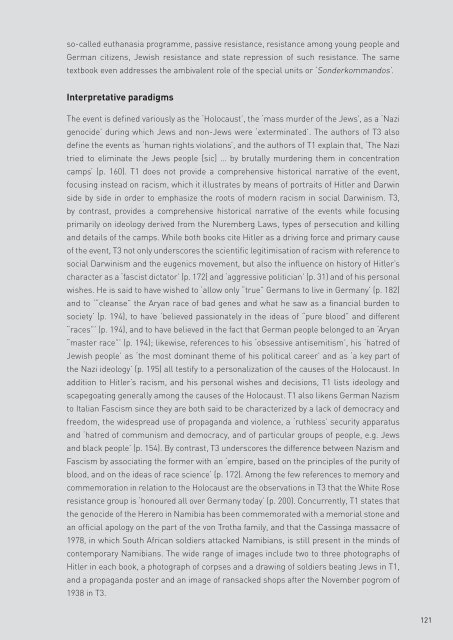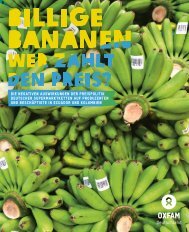228776e
228776e
228776e
You also want an ePaper? Increase the reach of your titles
YUMPU automatically turns print PDFs into web optimized ePapers that Google loves.
so-called euthanasia programme, passive resistance, resistance among young people and<br />
German citizens, Jewish resistance and state repression of such resistance. The same<br />
textbook even addresses the ambivalent role of the special units or ‘Sonderkommandos’.<br />
Interpretative paradigms<br />
The event is defined variously as the ‘Holocaust’, the ‘mass murder of the Jews’, as a ‘Nazi<br />
genocide’ during which Jews and non-Jews were ‘exterminated’. The authors of T3 also<br />
define the events as ‘human rights violations’, and the authors of T1 explain that, ‘The Nazi<br />
tried to eliminate the Jews people [sic] … by brutally murdering them in concentration<br />
camps’ (p. 160). T1 does not provide a comprehensive historical narrative of the event,<br />
focusing instead on racism, which it illustrates by means of portraits of Hitler and Darwin<br />
side by side in order to emphasize the roots of modern racism in social Darwinism. T3,<br />
by contrast, provides a comprehensive historical narrative of the events while focusing<br />
primarily on ideology derived from the Nuremberg Laws, types of persecution and killing<br />
and details of the camps. While both books cite Hitler as a driving force and primary cause<br />
of the event, T3 not only underscores the scientific legitimisation of racism with reference to<br />
social Darwinism and the eugenics movement, but also the influence on history of Hitler’s<br />
character as a ‘fascist dictator’ (p. 172) and ‘aggressive politician’ (p. 31) and of his personal<br />
wishes. He is said to have wished to ‘allow only “true” Germans to live in Germany’ (p. 182)<br />
and to ‘“cleanse” the Aryan race of bad genes and what he saw as a financial burden to<br />
society’ (p. 194), to have ‘believed passionately in the ideas of “pure blood” and different<br />
“races”’ (p. 194), and to have believed in the fact that German people belonged to an ‘Aryan<br />
“master race”’ (p. 194); likewise, references to his ‘obsessive antisemitism’, his ‘hatred of<br />
Jewish people’ as ‘the most dominant theme of his political career’ and as ‘a key part of<br />
the Nazi ideology’ (p. 195) all testify to a personalization of the causes of the Holocaust. In<br />
addition to Hitler’s racism, and his personal wishes and decisions, T1 lists ideology and<br />
scapegoating generally among the causes of the Holocaust. T1 also likens German Nazism<br />
to Italian Fascism since they are both said to be characterized by a lack of democracy and<br />
freedom, the widespread use of propaganda and violence, a ‘ruthless’ security apparatus<br />
and ‘hatred of communism and democracy, and of particular groups of people, e.g. Jews<br />
and black people’ (p. 154). By contrast, T3 underscores the difference between Nazism and<br />
Fascism by associating the former with an ‘empire, based on the principles of the purity of<br />
blood, and on the ideas of race science’ (p. 172). Among the few references to memory and<br />
commemoration in relation to the Holocaust are the observations in T3 that the White Rose<br />
resistance group is ‘honoured all over Germany today’ (p. 200). Concurrently, T1 states that<br />
the genocide of the Herero in Namibia has been commemorated with a memorial stone and<br />
an official apology on the part of the von Trotha family, and that the Cassinga massacre of<br />
1978, in which South African soldiers attacked Namibians, is still present in the minds of<br />
contemporary Namibians. The wide range of images include two to three photographs of<br />
Hitler in each book, a photograph of corpses and a drawing of soldiers beating Jews in T1,<br />
and a propaganda poster and an image of ransacked shops after the November pogrom of<br />
1938 in T3.<br />
121




